There are some places in the world that bear in their name the unmistakable tang of adventure. The Congo, Borneo, the Himalayas are amongst them, but, for me, ever since a teenage reading of Bruce Chatwin’s seminal book, Patagonia has been at the top of the list. It’s the whole “end of the world” feel that this enormous region spanning the Chile-Argentina border has that is a large part of the attraction. It’s a region of Antarctic Explorers, Cape Horn, Darwin’s voyages, Welsh missionaries, glaciers, fjords and mountain ranges. Condors soar on the thermals and Guanacos and Rheas stalk the plains. It is wild and beautiful and recently I was lucky enough to visit and, in spite of the odd injury sustained, undertake some epic hikes in some of the most spectacular scenery I have ever had the good fortune to encounter. Even in three weeks we only covered a fraction of the region, which is great, as it gives me an excuse to plan a return trip in the future.
The main towns on the Chilean side of the border are Punta Arenas where we visited the Magellanic Penguins on Isla Magdelena and Puerto Natales which is the base for visitors wanting to trek in the Torres Del Paine National Park which is the home of the famous W and O trails. The park was formed in 1959 and is one of the most popular in the region. The W trek is 50 miles long and takes you through some of the most spectacular scenery I have ever encountered. Whilst certain sections do feel quite remote and there is little phone signal on the trail, it is a popular route and there are excellent refugios and well organised campsites en route. The bus from Puerto Natales takes you to the Park gates and from there a transfer service runs you to the Visitors Centre and the area that contains a couple of refugios and also a very swanky hotel. It all worked incredibly smoothly and we got great views of the wildlife from the bus.
Day 1- This is a tough day’s hiking and can be done either as day 1 of the W trail or as an out and back day walk. We set off from the Refugio Central after leaving one of our bags there, thus making the load a little lighter for whichever of us was carrying it. It is a pretty steady climb for the first section that takes you into the Ascencio Valley and already affords some great views in all directions. After the appropriately named Windy Pass the path drops down towards the Ascencio River and the Chileno Refugio where we topped up our water. The trail crosses the river and continues through some beautiful forest where we stopped for lunch before the most notorious section, the boulder field. It is a slog up to the famous Mirador de las Torres, there is scree, boulders and endless twists and turns, but the view when we arrived was everything we could have hoped for. We had been taking it pretty easy on the way up so the crowds had thinned a little by the time we got there, the famous towers swum in and out of the cloud above a beautiful blue lake that was still partially frozen, it was spectacular. Unfortunately as we descended, and it is a tough descent, Thalia’s knee started to give her trouble which meant our descent was slow and (for Thalia, very painful). We had snow flurries and a gradually fading light but made it down to the refugio where a huge portion of stew was waiting for us and where the Austral Brewery beer went down very well indeed. We were pretty concerned however at how Thalia’s leg was feeling so resolved to play a wait and see game in the morning before making any further plans.
Day 2- After a good night’s sleep and some breakfast we decided that we were going to crack on! After retracing our steps for the first half an hour we branched off towards Sector Frances and instantly the views cranked up another level as the sun came out and the sky became a perfect blue. We passed grazing horses and then followed the path as it wound high above the shores of the blue/green Nordernskjold Lake, the colour of the water being almost other worldy it was so vibrant. The next scenic highlight was our first view of Los Cuernos, or The Horns, jagged rugged peaks with such variation in the rock colour that they looked like they’d been dipped in chocolate. They would be with us for most of the rest of the trip and are rough, brutal looking peaks. The refugio bearing their name hadn’t opened for the season yet so we had to press on and we were both feeling pretty weary by the time we reached Camping Frances. We had a pre-erected tent here, and it was also here I discovered I had managed to leave our passports at the first Refugio. The staff here and at Paine Grande were incredibly helpful in eventually reuniting us with them. We had another excellent meal in the cafeteria before crawling into our sleeping bags to the sound of wind in the trees overhead and the pitter pattering of rain on our tents. It was a brilliant day of walking but an exhausting one and the collective knees weren’t getting any better!
Day 3- At breakfast, over yet another mug of coffee, we came to the tough decision that we needed to prioritise enjoyment over completion and we were going to turn the W into an L. A few years ago I would have found this hard, but I have genuinely reached a point now where I am happy with what I do and not regretting what I don’t. So, we decided we were going to skip Valley Frances and we were going to finish a day early at Paine Grande and just take a short day walk before the ferry…..decision made we had a lovely, relaxed, sunshiney walk on day 3. As everyone else has headed up the valley we had the trail to ourselves for most of the day. We passed the forlorn looking Italian camp in a cloud of drizzle which then burned off and the rest of the day was beautiful. We passed forests of ghost trees and stopped for lunch at a perfect lookout above Skottsberg Lake with views of Los Cuernos, it was really wonderful. The last leg into Paine Grande, a beautifully situated refugio on the bans of Pudeto Lake saw the famous Patagonian wind starting to pick up for the first time but also gave us really close views of three iconic Andean Condors playing in the skies above us. It’s a great way to end this leg and the staff, food, hot showers and views from the refugio were all just about perfect.
Day 4-The wind was fierce! From our dorm we could see waves skittering and scudding across the lake and we could hear the Chilean flag flapping and that vicious, primeval howling of a really powerful wind. We had time to kill before the ferry linking the buses back to Puerto Natales. Our passports were due to be waiting for us at the park gates, a fingers crossed kind of situation! In the end we walked slowly, for a couple of miles up to a body of water known as the Lake of the Ducks. The wind was unbelievable. When you read a lot of outdoor social media, you often read of people boasting of being out in 100mph winds. The Patagonian forecast reckoned we were experiencing gusts of 80mph, and there’s no way anyone could stand up in stronger than that. It was a surreal experience to be physically moved by the wind and made for an entertaining and adventurous last day on the trail. We made it back in one piece, hopped on the ferry, then the bus, collected our passports and made it back to our hostel to sleep the sleep of the dead.
So, the L trail, comes very highly recommended. I am sure that we would have loved Valley Frances and the Grey Glacier but it wasn’t to be and the experiences we shared on this walk will always be some of the best I have anywhere. It felt wild and remote but we were so well looked after. I liked the fact that there is no concession, no paddling on lakes or zipwires or any other fripperies, it’s just a wild, rocky trail through beautiful scenery that exists without any real regard for the humans making their way over to see it. We had the most amazing time. Anyone like to come with us next time 🙂 ?
HOSTAL ALCAZAR, PUERTO NATALES
In Puerto Natales we stayed here

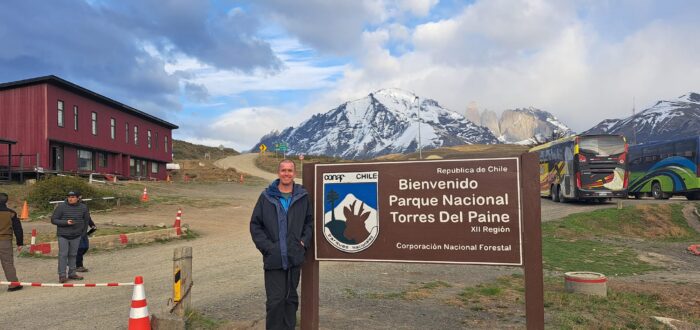
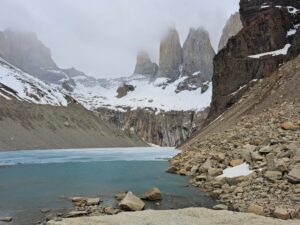
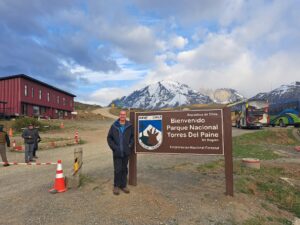
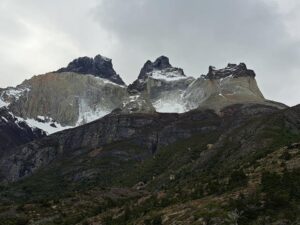
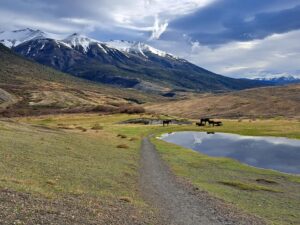
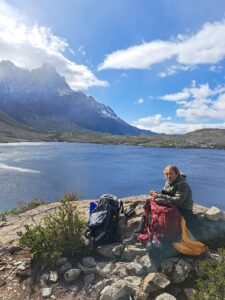
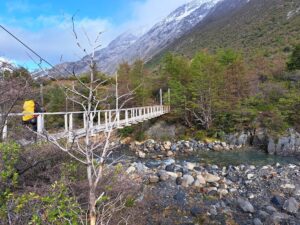
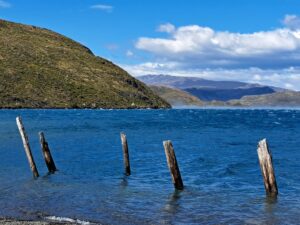
Excellent Ian. Great to read and reminisce about our own trip to Patagonia nearly 10 years ago. I still remember how wild and remote it felt, and of course the stunning beauty. Glad you had a great time.
Hi mate, I am glad that the blog bought back some great memories for you. It really is one of the most special places!
Always better to regret something you have done, than something you haven’t. Good decision to put enjoyment of achievement.
Yeah, it definitely took me a while to get to that way of thinking but now it’s ingrained I feel a lot better for it!
The most spectacular scenery I have ever seen, with the most complicated logistics. Thank you for organising such an amazing trek, I can’t wait to go again.
Yeah, it has definitely moved into my top 3 now along with New Zealand and Nepal!
Brilliant blog Ian, it is one of those places I’ve always dreamt of going to, and to see your pics and explanation of the routes has been fabulous…I’m very jealous of you…and now just need to get saving my pennies…😀
Thanks for the kind words Nik. It is definitely worth it for a once in a lifetime trip!
Looks awesome mate, your recce paid off well! 🐨
It’s an incredible place and well worth a visit !
It sounds amazing!
Thank you. It really is. Not just the landscape but the people and the food and drink and the wildlife. It’s the full package!
I too have always wanted to visit Patagonia. Reading your blog helps me feel as though I’m there.
Going with you next time sounds good.
Thanks Martin. I am glad you liked the blog. Look forward to hearing from you and planning an epic adventure 😉
Looks like an amazing place and the food, beer and wine look great too.
Love to go
It really is Ian. And, yes, the food and drink were one of the highlights, it wasn’t just about the landscape!!
Fantastic to read and reminisce about our own trip to Patagonia almost a decade ago. We did a very similar route. I also remember how wild and remote it felt, one of the best places we visited. Inspiring read mate and makes me want to return!
I’d love to go back already. It’s a very special place and we only scratched the surface of it!
Testimonials
Recent Posts
Categories
Recent Posts